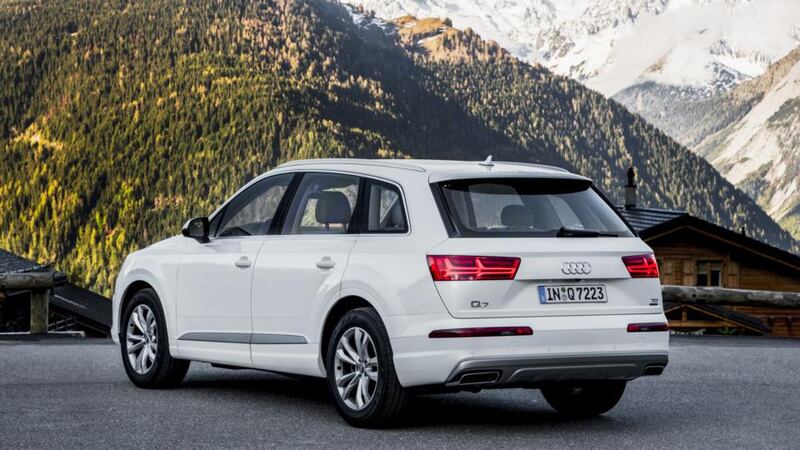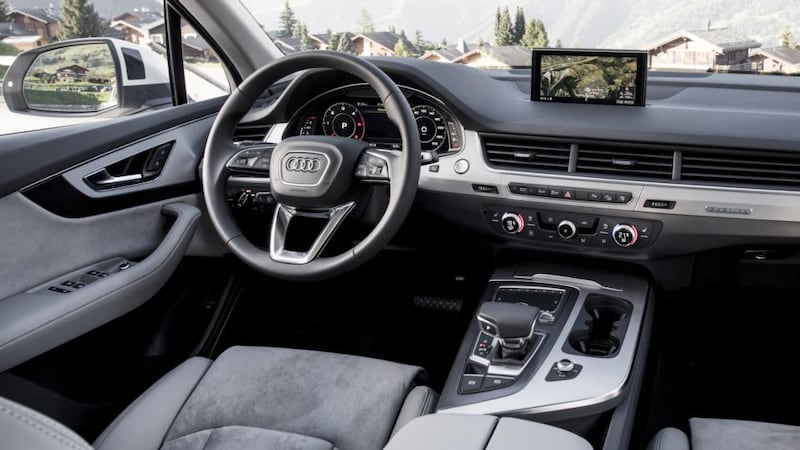Audi’s behemoth doesn’t seem so big anymore. With its enormous grille, like a garden gate welded to the front of a small tank, the first generation Q7 had the menace of something from a Mad Max movie.
When Audi decided to compete for SUV buyers it wanted to make some noise about it: the Q7 did just that, with all the subtly of a bullhorn. It was perhaps a little too big and brash, but in its defence it was of its time: it had the swagger of a boom-time SUV and its owners sat so tall in the car not because of a raised seating position, but because their wallets were in their back pockets.
Perhaps it’s a sign of the times or the fact that so many cars now carry the SUV silhouette, but this latest Q7 isn’t half as imposing as the original.


In fact when I first came across a hangar full of the new models ready for the road, I initially thought it was a fleet of Q5s, the smaller Audi crossover. In physical terms the car is no lower, no slimmer and only 3cm shorter than the outgoing Q7, but somehow by tweaking the look Audi has created a vehicle that looks less imposing than before. Not quite a subtle SUV but far less bold and brash than its new arch-rival, the big-grilled Volvo XC90.
According to the Audi experts at the launch, customer feedback highlighted two priorities for potential buyers: design and connectivity. So the German premium brand is understandably making much of these features of the car.
In terms of styling I’m not quite won over. By losing its brash demeanour they have lost some of the car’s unique character. However, there’s no question but that there’s a wealth of tech features certain to impress the most connected tech geek.
It’s hard to sum up all the features on offer in the new Q7 but I’ll try and give you a snapshot. Adaptive cruise control lets you leave the car in cruise control while maintaining a safe distance to the traffic in front, regardless of the speed. This can be teamed up with lane-keeping assist, which monitors the lines on the road and gently adjusts the steering.
Then there’s traffic jam assist that monitors the road ahead, the surrounding vehicles, reads the road signs and the road lines and will steer, brake and accelerate the Q7 in heavy traffic up to speeds of 65km/h. Audi is very wary about suggesting this is autonomous driving but clearly it frees the driver from the start-stop stress of traffic.
Parking aids
Then there are the multiple parking aids. With the driver simply in charge of brakes and acceleration the Q7 will park itself into parallel spots or the usual perpendicular car park spots.
Another option to add on is all-wheel driving steering, which slightly turns the rear wheels between 5km/h and 15km/h and can reduce the turning circle by up to a metre. The Brown Thomas car park will never cause Q7 owners a moment’s anxiety again.
In terms of entertainment, as you lounge back in the comfy leather seats, there is Audi's new 3D sound system and, from the end of year, Apple's CarPlay connection, which lets a few selected apps operate via the car's main control screen. While CarPlay is certainly overhyped for what it is, the addition of Google Maps view in the sat-nav is a big bonus feature for the driver, while the Connect package that offers in-car wifi hotspot access is great for passengers.
Audi is also offering its own rear-seat Android tablet computers for back seat passengers at a price of €1,760 for one, but you’re not safe to be let out on your own if you spend that sort of cash for a glorified tablet computer, similar versions of which are on sale in discount German supermarkets at a tenth of the price.
All this is offered up to occupants in a cabin that remains the best in class. There's a mix of opulence and quality engineering in the way Audi delivers in-car systems these days. And it's the little touches that impress, such as the digital temperature display on the temperature control knob or the sharp resolution of the virtual cockpit binnacle. Without suggesting any links between the two, there's the air of Apple about the whole enterprise.
What’s more, the new Q7 is noticeably far more roomy inside than the previous version. Headroom – always an issue surprisingly enough in the outgoing big Audi – is much better, as is elbow room.
And with seven seats as standard in Irish Q7s, access to the third row is impressively easy, assisted by a second row that flips twice to give you legroom. The third row also flips up and down electronically at the touch of a switch in the boot. All three seats in the middle can slide forward and back individually as well.
A big boon for well-heeled families is the fact you can get three child seats across the second row, something surprisingly few cars can manage to date. This means the Q7 can accommodate a whopping six child seats. This feature alone should make it a kindergarten favourite in the well-heeled suburbs, with happy foreign au pairs behind the wheel bopping along to their favourite radio station from back home courtesy of the TuneIn radio streaming through Apple’s CarPlay system.
Small grand piano
Audi’s other big message for the Q7 is efficiency: the lowest emissions in its class, and a car that sheds up to 325kgs compared to the previous model. Engineers are eager to point out this is the equivalent weight of a small grand piano or the front row of the Irish rugby team. Impressive, I think you’ll agree, though everything is relative and the new Q7 still hits the scale at over two tonnes in unladen weight, or, as Audi engineers would probably put it, the equivalent weight of a white rhinoceros.
By shedding weight the Q7 delivers some very respectable figures – for the best-selling 218bhp 3-litre diesel version it means fuel economy of close to 6 l/100km (47 mpg) and emissions of 148/km resulting in an annual motor tax bill of €390. That’s a healthy saving on the current €750 annual bill for the current 3-litre 204bhp diesel Q7.
Efficiency and fuel economy are important for these cars as a counter to the common perception of large SUVs as “gas guzzlers”.
In terms of driving dynamics the car is remarkably nimble for its size and it was noticeable on some particularly tight hairpin bends when descending some alpine mountain passes in Switzerland that the Q7 is easy to drive. There’s nothing too sporty or dynamic about its handling and the steering always felt a little light, but that could have been also due to the winter tyres fitted to the test cars. As a big SUV it’s all about ease and comfort rather than sports car sharpness.
Three engines are offered to Irish buyers: the aforementioned 3-litre diesel putting out 218bhp and the same V6 powertrain with 272bhp. A 3-litre petrol 333bhp is also on offer but don’t expect to see too many on this island. All are mated to a smooth eight-speed transmission. Prices start at €72,125 for the 218bhp, rising to €78,125 for the 272bhp version.
I tested both of the diesels and the 218bhp is more than capable of the task at hand. The extra €6,000 if you have it is much better spent on a shopping spree on the options list or upgrading from entry SE and its rather dull 18-inch alloys to the mid-range SE Business level, which gets you 19-inch alloys, sports seats and the acclaimed virtual cockpit for €4,400. Then throw on the Tech Pack at €4,500 and you are ready to impress any tech-savvy teen.
Finance package
The Q7 is also offered through the PCP finance package at an average APR of 4.9 per cent and a monthly cost starting at €759.
Overall, Audi has delivered on customer demands, and even if the styling is not to my taste, there’s no question that it’s both an easy and comfortable car to drive, and a luxurious place to be.
It arrives on the market within months of the new Volvo XC90 and a new BMW X5, so it’s probably best for potential buyers to try all three before signing on the dotted line. I’ll also reserve judgment until we try all three but for now it’s safe to say the Q7 meets its customer demands for comfort and connectivity, while delivering impressive efficiency savings on the outgoing model.
Lowdown: Audi Q7
Engines: three engines on offer in Ireland, starting with 3-litre diesel in 218bhp and 272bhp guise and a 333bhp 3-litre petrol
Fuel economy (for 218bhp version): 6 l/100km (47mpg)
Emissions (motor tax): 148g/km (€390)
0-100km/h: 6.5 seconds
Features: Entry SE level gets as standard 18-inch alloys, leather seats, acoustic glass, parking sensors, pre-sense city safety system; electric boot door.
Arriving: In showrooms from July (218bhp version arriving later in the year)
Prices: Starting at €72,125 for the 218bhp diesel in SE specification (all Irish cars will come with seven-seats as standard).
















